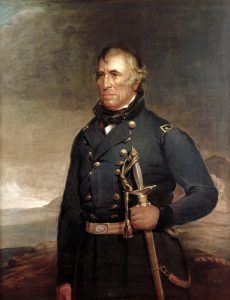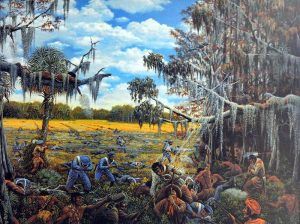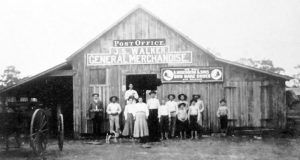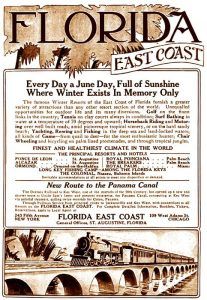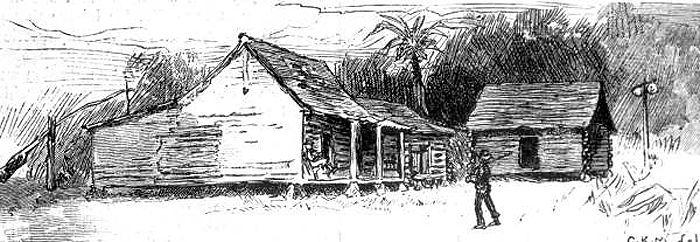
Fort Basinger, Florida
Fort Basinger was a U.S. Army military post and a town in Highlands County, Florida. Both are gone today, except for a single historic homestead.
In 1837, a U.S. Army fort was established by Colonel Zachary Taylor during the Second Seminole War on the south bank of the Kissimmee River. It was named for Lieutenant William E. Basinger, 2nd U.S. Artillery, who was killed at the Dade Massacre on December 28, 1835. The post was one of a series of small, temporary supply posts established along Taylor’s route from Fort Brooke at Tampa to Lake Okeechobee. The fort included a log palisade with blockhouses at opposing angles. After supplies and heavy baggage at the post, Colonel Taylor pressed on to Lake Okeechobee to round up several Seminole Indians who resisted removal to Indian Territory (Oklahoma).
On December 25, 1837, while Taylor and about 800 troops were making their way to Lake Okeechobee, they were ambushed by about 400 Seminole Indians under chiefs Alligator, Billy Bowlegs, and Abiaca. As the soldiers moved toward the lake, they came upon a large stand of trees with half a mile of swamp in front of it. Lake Okeechobee lay beyond it. As Taylor moved his troops on foot squarely into the center of the swamp, they were hit from all sides by warriors perched in the treetops. Colonel Taylor and his troops were forced to retire to Fort Basinger. The U.S. forces suffered 26 killed and 112 wounded, while the Seminole had only 11 killed and 14 wounded. The Battle of Lake Okeechobee stopped Taylor’s troops from further advance south for the time being, and no Seminole were captured.
Though the Seminole won the battle, Colonel Taylor demonstrated the ability of U.S. forces to penetrate deep into Seminole territory with large forces, which, with improved tactics, the U.S. Army would prevail in the removal effort.
The fort was officially abandoned in 1850 but was utilized again during the Third Seminole War, which lasted from 1855 to 1858. Afterward, the surrounding area remained largely settled until after the Civil War.
Slowly, a few pioneer families, mostly cattle ranchers, farmers, and trappers, started moving into the area in the 1870s. The town of Basinger was established on the northeast side of the Kissimmee River in present-day Okeechobee County.
In 1875, Captain John Mizell Pearce, who had served in the Third Seminole War and as a captain in the Civil War, was deeded 157 acres of land on the southwest side of the river, which included the old fort. The Pearce family became one of the first to settle in what would become Highlands County. Pearce built a pine log home for his family, ran a cattle business, and started a steamboat ferry across the Kissimmee River to Basinger. In addition to running his cattle and ferry business, Pearce served as Deputy Sheriff, and for some time, he was the only law enforcement in the lower Kissimmee River Valley.
In the meantime, the town of Basinger began to grow, and by 1878, enough people had moved to the town to support a general store. By 1880, there was a school. The town quickly became prosperous as its location along the river allowed it to become a hub of activity, where crops were shipped out and goods were brought in on steamers. Steamboats also took passengers north to Kissimmee, which connected the town to the railroad system. The first post office was founded in 1893 under the name “Bassenger.”
Captain Pearce died at Fort Basinger in 1897, and his wife Martha and son, Sidney, ran the ranch together. A couple of years later, she began building a larger home overlooking the Kissimmee River about 1.5 miles north of their earlier cabin. This would later become the Pearce Lockett Estate.
By the turn of the century, the community of Basinger was a bustling cowboy town with two hotels, a general store, a clothing store, a schoolhouse, a church, and thriving social activities. That year, the 1900 Census reported 338 people on the Okeechobee County side in Basinger and another 165 living on the Highlands County side at Fort Basinger.
In 1911 Martha Pearce died, and her son Sidney, bought her homestead from the estate, and he and his wife and children moved in. Sidney donated land to the community for the Fort Basinger School, which allowed up to 50 students from the area to attend, including his children. He and his son, Cliff, ran the ranch while his daughters, Pearl and Edna, grew up to teach in the school that their father built.
In the meantime, Basinger began to lose population in 1915 when the Florida East Coast Railroad bypassed Basinger in favor of Okeechobee, some 20 miles to the southwest. The Bassenger post office closed in 1918. A final blow came to Basinger when the steamships stopped running in the 1920s due to improved roadway networks.
However, at about the same time, hopes for both towns were rekindled during the Great Florida Land Boom of the early 1920s. Huge land deals were struck on both sides of the river that investors believed would net huge profits. Various newspapers hailed that the “new” town would “become a city with 5,000 to 8,000 population… within five years or less.” A new post office was granted in 1925 on the fort side of the river and was called “Fort Basinger.” At this point, the community had five stores, three blacksmith shops, two churches, a saddle shop, and the Fort Basinger three-room school with 150 students and three teachers.
Two real estate companies were formed, including the Fort Bassinger Corporation, incorporated in 1925, and the Bassenger Development Corporation in 1926. But it was too late. The boom stopped as suddenly as it had started, and over the next few years, a series of freezes and hurricanes sent Florida into a depression before the stock market crash of 1929.
Fort Basinger dwindled during the Great Depression, its businesses closed, and most people moved away. One of the families that stayed was the Pearces. Though the community near them was dying, they continued to operate the ranch and the school. In 1934 Cliff Pearce was killed in an automobile accident. Afterward, the women — Clara, Cliff’s wife, Edna, and Pearl– began to help their father, who was in his 60s, run the ranch when the school was closed.
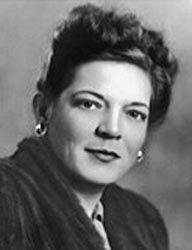
Edna Pearce Lockett
Eventually, Edna’s sister and sister-in-law moved away from the homestead, and Edna became the sole owner of the ranch. She would become one of the most influential women in Florida history, serving as an officer in the Highlands County and Florida Cattleman’s Associations and becoming the third woman elected to the Florida House of Representatives, where she served three terms before she retired. She married James Lockett in 1953 and, afterward, kept busy with the ranch and civic, political, and social activities. From 1962 through 1970, Edna was one of the founding board members of the Highlands General Hospital and Youth Care Home in Highlands County.
Edna spent the rest of her life on the ranch until she died in 1991. At the time of her death, her property was included in a trust that specified that her home “insofar as possible, be set aside by the Trustees as a historical site.” Her estate also included the ranch, comprised of 7,741 acres. Most of the land and cattle had to be sold for an outstanding mortgage and substantial tax liabilities. In the end, the South Florida Water Management District obtained the Pearce-Lockett residence and other historical sites as part of several hundred acres needed for the Kissimmee River Restoration project.
For years, the residence and its outbuildings were maintained as the Water Management District tried to partner with numerous county, state, and federal agencies to maintain and operate the property as a museum and historic site. However, there were no takers.
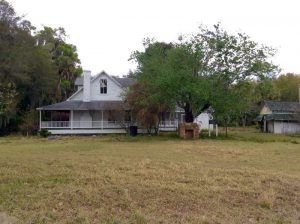
Pearce Lockett House, Fort Basinger, Florida by Black Doll Flickr
In 2015, the website Abandoned History had this to say about the old homestead:
“The Lockett Estate and Basinger are just shadows of what they once were. There are no remains of the fort, and the hotels and general store are long gone. Neglect and age are starting to take a toll on the buildings of the estate. The main house has rotting floors and roof. The barn is barely standing, and several other smaller buildings are beginning to fall from neglect. There are several concrete lamp posts lining the originally drive, but some have fallen over and the boathouse along the river is showing signs of the river’s rise and fall. One of the most important features is the Pearce family cemetery which is nestled under oak trees along Hwy 98. While the property is not being maintained, the cemetery has been secured to prevent wild hogs from destroying the headstones and disturbing the plots.”
In 2017 the Water District placed the historic homestead for sale at a surplus auction, and it was sold. Unfortunately, we were unable to determine its current status.
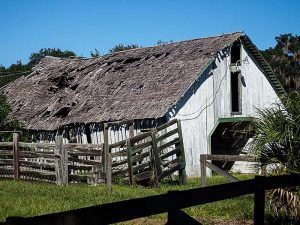
Pearce Lockett Barn, Fort Basinger, Florida, by Jim Dourney, Abandoned Florida
There are no remains of the town of Basinger in Okeechobee County or old Fort Basinger on the Highlands County side today except for the Pearce Homestead. The fort was located south of the town of Fort Basinger at the Highway 98 bridge across the Kissimmee River. The site of the Pearce-Lockett Homestead, which includes the residence, a barn and outbuildings, a family burial plot, and a schoolhouse, is also located on Highway 98, just a short distance northeast north of its junction with County Road 721. Basinger was located just across the Kissimmee River.
© Kathy Alexander/Legends of America, updated November 2022.
Also See:
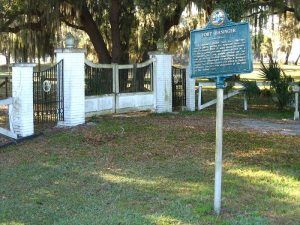
Fort Basinger, Florida Historic Marker
Sources:
Abandoned Florida
Florida Atlantic University
Florida History
Fort Wiki
Lake Okeechobee News

